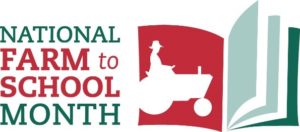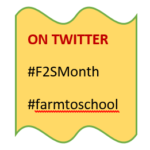Celebrate National Farm to School Month

In 2010, the U.S. Congress designated National Farm to School Month to recognize the impact of such programs in improving child nutrition, supporting local economies and educating children on where food really comes from. One Small Step is the theme of this year’s campaign, to show how easy it can be to inform and inspire others to grow farm to school programs within their communities and across the country. Goals for the 2016 campaign:
- Highlight innovation in
- reaching new audiences
- raising awareness
- encouraging action
- Showcase partners
While there is not a set template for farm to school programs, all are built on three components:
- Procurement. The purchase and promotion of local foods.
- Education. Involving children in activities that teach them about agriculture, food, health or nutrition.
- School gardens. Hands-on activity includes learning first-hand about livestock, hydroponics, and other food production systems.
Since 2007 a collaborative work of 30 organizations, the National Farm to School Network, has advocated community partnerships linking local food sources – farmers, fishers, ranchers, food processors and food manufacturers – to school districts across the country. Over 12,000 practitioners and supporters are working with nearly 43,000 schools across the country, impacting an estimated 23.6 million students.

School gardens have blossomed, providing expanded access to fresh food to children of all ages and to food banks as well. The NFSN delivers to students, families and their communities hands-on agricultural, nutritional and food education. It also supports farmers and helps local economies to flourish.

What defines “local” varies by State; from a radius of miles (which can include crossing state borders) to everything within state borders. However it is defined, the potential for growth is enormous. In the USDA Farm to School Census taken for the 2013-14 school year, nearly $790 million was spent on local food from farmers, ranchers, fishermen, food processors, and manufacturers. This was an increase of 105% from 2011-12, the school year in which the census was first conducted.
ECONOMICS
Economic studies on the impact of farm to school programs estimate that buying food locally generates economic activity of between 40 cents and $1.60 for every dollar spent. This could lead to over a billion dollars being fed into a community, district or region. This includes the creation of new jobs to assist with the growth and distribution of locally grown foods.
DIG IN (yes, I had to say that…)
Organizations and individuals are invited to join the FSFN by participating in or arranging local activities during October. Activity starts now with a petition to support a new bill, the Farm to School Act of 2015 which builds on the USDA Farm to School Grant Program, increasing access to fresh foods to preschools, summer and after-school programs. It also supports tribal, beginner, veteran and disadvantaged farmers. If passed, the Act will become a part of the reauthorized Child Nutrition Act of 2015.
Signing the pledge automatically enrolls you in a sweepstake to have NFSN support your school of choice in developing its farm to school program. And you’ll receive weekly Small Step emails as well.
Those who sign up as outreach partners will:
- Commit to promoting the month on their regularly used social media sites

- Share with the NFSN how many people those channels reach
- Use farm to school as the theme of blogs, calls, etc.
- Content is provided in the downloadable communications toolkit (a Word document).
- Follow
- on Twitter at @FarmtoSchool
- on Instagram at @FarmtoSchool
- on Facebook
- Utilize the toolkits and graphics that will be sent each week in October. Weekly themes:
- Education (garden how-tos, cooking lessons, about agriculture)
- Healthy School Meals
- Farmers and Producers
- Next Generation (innovative models, looking ahead)
- Submit photos and stories that could get featured in the NFSN blog
- Schedule a field trip to a garden, farm or food production site
- Invite an elected official to have lunch at their favorite school
For some children, breakfast, lunch, and snacks at school are their best access to nutritious foods. October draws awareness of the bodies and minds fed, literally and physically and the hands and hearts that reach out to feed them while building communities – large, small, rural, tribal, urban, all.
amzn_assoc_placement = “adunit0”;
amzn_assoc_search_bar = “false”;
amzn_assoc_tracking_id = “trybackfarm-20”;
amzn_assoc_ad_mode = “search”;
amzn_assoc_ad_type = “smart”;
amzn_assoc_marketplace = “amazon”;
amzn_assoc_region = “US”;
amzn_assoc_title = “Items you may enjoy”;
amzn_assoc_default_search_phrase = “seeds”;
amzn_assoc_default_category = “All”;
amzn_assoc_linkid = “7a8bd5a27e2e774aba4813ab8726761a”;
amzn_assoc_rows = “2”;
Check out these products as well!